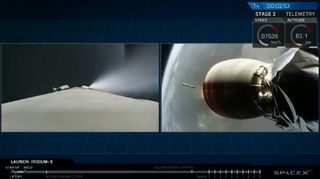What's the Deal with SpaceX, NOAA and Live Rocket Launch Video?
Whenever SpaceX launches a rocket, you can bet the views will be spectacular. After all, SpaceX has cameras up and down its Falcon 9 rockets that offer live views from space as each booster soars into (and sometimes back from) space.
So it was weird today (March 30) when, 9 minutes into an otherwise routine Falcon 9 launch of 10 Iridium Next communications satellites from California's Vandenberg Air Force Base, SpaceX cut the feed. The video blackout was intentional because of "restrictions" from a U.S. government agency known for its own live views of Earth from space.
"Due to some restrictions from the National Oceanic and Atmospheric Administration, NOAA for short, SpaceX will be intentionally ending live video coverage of the second stage just prior to engine shutdown," SpaceX materials engineer Michael Hammersley said during a live webcast commentary of the Iridium-5 mission. "We're working with NOAA to address these restrictions in order to hopefully be able to bring you live views from orbit in the future."

Those restrictions, Space.com has learned, apparently hinge on a recent NOAA assertion that the cameras on SpaceX's Falcon 9 second stage can qualify as a "remote sensing space system," which would require a provisional license from the U.S. agency if SpaceX wanted to show the live video and still launch on time.
SpaceX has webcast live views from rocket cameras on most, if not all, of its Falcon 9 launches and recently surpassed its 50th flight for the workhorse booster. And other U.S. launch providers, like the United Launch Alliance and Orbital ATK, have streamed live video from their rockets as well.
Last month, when SpaceX launched its first Falcon Heavy rocket on Feb. 6, the heavy-lift booster's second stage beamed home spectacular video of a Tesla Roadster— SpaceX CEO Elon Musk's own car — from three different cameras. Some of those views showed the Roadster with a crescent Earth in the background. SpaceX's "Starman" mannequin was at the wheel in a spacesuit.
So, what's the deal? In a statement released this afternoon, NOAA officials said it's all about cameras.
Get the Space.com Newsletter
Breaking space news, the latest updates on rocket launches, skywatching events and more!
"The National and Commercial Space Program Act requires a commercial remote sensing license for companies having the capacity to take an image of Earth while on orbit," NOAA officials wrote in the statement "Now that launch companies are putting video cameras on stage 2 rockets that reach an on-orbit status, all such launches will be held to the requirements of the law and its conditions."
That means SpaceX had to apply for a license to livestream the video from its Falcon 9 second stage, which the company did. Though apparently, NOAA's approval came with some strings attached for at least this mission.
"SpaceX applied and received a license from NOAA that included conditions on their capability to live-stream from space," NOAA officials explained. "Conditions on Earth imaging to protect national security are common to all licenses for launches with on-orbit capabilities."
SpaceX does not expect to have a similar issue with its next launch on Monday (April 2), when it will launch a used Falcon 9 rocket carrying a Dragon cargo ship (also previously flown) to deliver NASA cargo to the International Space Station.
Visit Space.com Monday for live coverage of that SpaceX Dragon launch beginning at 4 p.m. EDT (2000 GMT). Liftoff is scheduled for 4:30 p.m. EDT (2030 GMT) from a SpaceX pad at Cape Canaveral Air Force Station in Florida.
Editor's note: This story, originally posted at 12:37 p.m. EDT, has been updated to include NOAA's statement on the restrictions placed on SpaceX's second-stage launch video.
Email Tariq Malik at tmalik@space.com or follow him @tariqjmalik. Follow us @Spacedotcom, Facebook and Google+. Original article on Space.com.
Join our Space Forums to keep talking space on the latest missions, night sky and more! And if you have a news tip, correction or comment, let us know at: community@space.com.

Tariq is the Editor-in-Chief of Space.com and joined the team in 2001, first as an intern and staff writer, and later as an editor. He covers human spaceflight, exploration and space science, as well as skywatching and entertainment. He became Space.com's Managing Editor in 2009 and Editor-in-Chief in 2019. Before joining Space.com, Tariq was a staff reporter for The Los Angeles Times covering education and city beats in La Habra, Fullerton and Huntington Beach. In October 2022, Tariq received the Harry Kolcum Award for excellence in space reporting from the National Space Club Florida Committee. He is also an Eagle Scout (yes, he has the Space Exploration merit badge) and went to Space Camp four times as a kid and a fifth time as an adult. He has journalism degrees from the University of Southern California and New York University. You can find Tariq at Space.com and as the co-host to the This Week In Space podcast with space historian Rod Pyle on the TWiT network. To see his latest project, you can follow Tariq on Twitter @tariqjmalik.
